.
Go, tell the Spartans, stranger passing by, That here, obedient to their laws, we lie. –– epitaph at Thermopylae (Simonides's epigram)
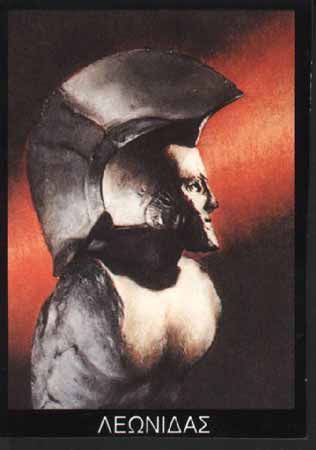
Leonidas I was a king of Sparta, the seventeenth of the Agiad line. He was one of the sons of King Anaxandridas II of Sparta. He succeeded, probably in 489 or 488 BC, his half-brother Cleomenes I, whose daughter Gorgo he married.
In 480 he was sent with about 7000 men to hold the pass of Thermopylae against the army of Xerxes of Persia. (see Battle of Thermopylae). The small size of the force was, according to a contemporary story, due to the fact that he was deliberately going to his doom, an oracle having foretold that Sparta could be saved only by the death of one of its kings: in reality it seems rather that the ephors supported the scheme half-heartedly, their policy being to concentrate the Greek forces at the Isthmus.
Several anecdotes demonstrate the laconic matter-of-fact bravery that Leonidas and the Spartans were famed for even in the ancient world. On the first day of the siege, when Xerxes demanded the Greeks surrender their arms, Leonidas is said to have replied Molon Labe ("Come and get them"). And on the third day, the king is reputed to have exhorted his men to eat a hearty breakfast, because that night they would dine in Hades.

Leonidas at Thermopylae, Jacques-Louis David (1814)
Leonidas' men repulsed the frontal attacks of the Persians for the first two days, but when the Malian Ephialtes led the Persian general Hydarnes by a mountain track to the rear of the Greeks, Leonidas divided his army, himself remaining in the pass with 300 Spartans, 700 Thespians and 400 Thebans.
Perhaps he hoped to surround Hydarnes' force: if so, the movement failed, and the little Greek army, attacked from both sides, was cut down to a man save the Thebans, who are said to have surrendered. Another theory was that Leonidas sent the remainder of the army home in an effort to preserve troops for the main battles of the war. The soldiers who stayed behind were to cover their escape so the Persian cavalry would not overrun the rear of the escaping troops.
Leonidas fell in the thickest of the fight; the Spartans attempted to retrieve his body, but given the numbers they faced, the body did fall into Persian hands. It was said (by contemporary Greeks) that Leonidas' head was afterwards cut off by Xerxes' order and his body crucified.
He was buried with full honors, including a very un-Spartan display of wailing and mourning (Spartans normally accepted death in battle as a matter of course and disapproved of outward grieving), and a carved lion was dedicated at his death site.
Our knowledge of the circumstances are too slight to enable us to judge Leonidas' strategy, but his heroism and devotion secured him an almost unique place in the imagination not only of his own time but also of succeeding times.


Leonidas Monument [Source]
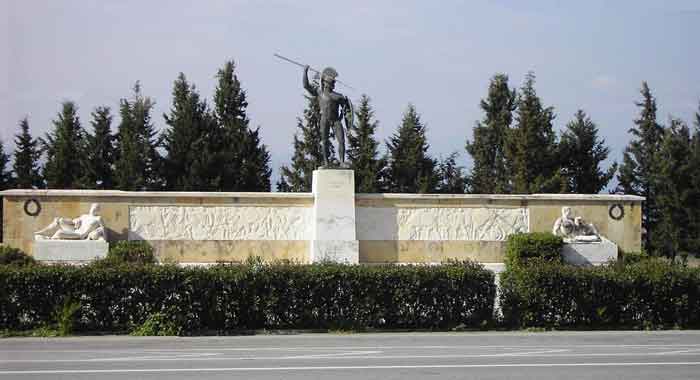
Leonidas Monument [Source]

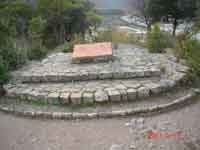

Arrow and Spear Heads used in the Battle of Thermopylae
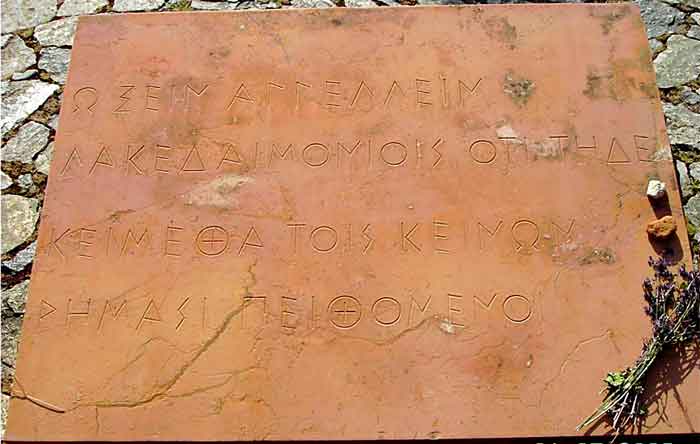
Leonidas Monument, Go, tell the Spartans, stranger passing by ,.... [Source]
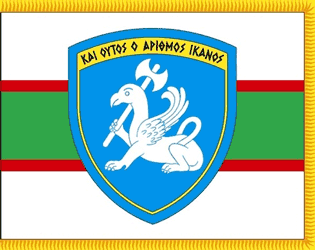
Emblem of the 15th Infantry Brigade , with the slogan "This number is good enough". When Leonidas was asked how he expects to stop the large number of Persian soldiers he said that the entire Greece does not have so many soldiers, but depending on how we fight this number is enough.
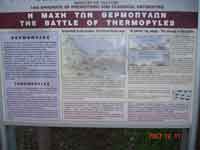
Agiad King of Sparta 489-480 BC
Preceded by: Cleomenes I
Succeeded by: Pleistarchus
See also
Aristodemus (Spartan)
| Ancient Greece
Science, Technology , Medicine , Warfare, , Biographies , Life , Cities/Places/Maps , Arts , Literature , Philosophy ,Olympics, Mythology , History , Images Medieval Greece / Byzantine Empire Science, Technology, Arts, , Warfare , Literature, Biographies, Icons, History Modern Greece Cities, Islands, Regions, Fauna/Flora ,Biographies , History , Warfare, Science/Technology, Literature, Music , Arts , Film/Actors , Sport , Fashion --- |
Retrieved from "http://en.wikipedia.org"
All text is available under the terms of the GNU Free Documentation License

